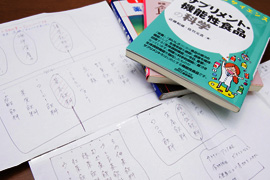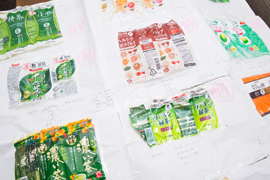- Student life
- Three fields of study
- Student's Graduation Thesis Theme
-
Student Blog
“Every day with Sha-an” - Award History
- Interview with Students
- Interview with Graduates
- Introduction of the Campus
- Campus Festivals
2. Societal Safety Science from the Perspective of Humans
Studying food from a safety science perspective
Research Theme
Problems related to the labels on Foods with Functional Claims whose kind is tea-based beverages
Chihiro Horiguchi of the Emiko Kanoshima research group
(Graduated from Osaka Prefectural Izumi High School)

Reasons for my interest in this subject
The Kanoshima research group is studying things familiar to everyday life, such as drugs (medicine), water, and food. When I was a third-year student, I had an opportunity to research the safety of health foods with other members of the research group. I have learned that even though health foods look the same, there are two kinds: Foods for Specified Health Uses (FOSHU) that have passed the official examination, and Foods with Function Claims (FFC) that have a mere notification without being examined. After I entered the university, I began to eat more health foods than before and wanted to know if health food is really safe. That is the reason for choosing FFC as the theme of my research.
Research Flow

First, I examined the difference between the ingredients of FOSHU and FFC regarding tea beverages. I classified bottled tea drinks into FOSHU and FFC and compared their ingredients written on the labels. As a result, it turned out that there is no significant difference in contents between them. I thought that maybe, if the ingredients are the same and the difference has accreditation only, FFC is cheaper than FOSHU and is more practical.
Therefore, I next examined the system of approval for FFC.

I read both on- and off-line documents to find out who approves and how products can be approved as FFC. I found out that although FFC doesn’t need national evaluation whereas FOSHU has government approval, it must still meet the standards established by the government. This means that companies report the safety information of their products to the Consumer Affairs Agency.
I had one question here. Is there a possibility that each company performs experiments in beneficial conditions because safety information to be submitted is independently investigated? Thus, I decided to research what kind of investigations are actually performed by companies.

The FFC safety information reported by companies is disclosed on the website of the Consumer Affairs Agency. After entering a notification number stated on each FFC package, anyone can view the method and content of the assessment. As a result of comparing the information, I found that the number of people surveyed and each company’s ingestion period for evaluating safety and functionality were utterly different. In other words, the level of scientific reliability for the information displayed on the products is different according to each company. Also, unlike FOSHU, I learned that there is no description as to how long you have to drink a product to see the effects described on the labels.

Labeling FFC is a new system that began in April 2015. Its purpose is to increase the number of products that display their effects in an easy-to-understand manner, so that consumers can obtain the correct information on products for product selection. However, if the criteria differ from company to company, it is doubtful whether the correct information is provided.
Also, for health-conscious consumers who purchase FFCs, information on how long and how much they have to drink a product to see the stated effects is important. I think that it is a problem that no such information is described on the label.
Through this research, I felt that there are still points to be improved in order for FFC to be beneficial to consumers.
Our next step!
Through information gathered from documents and the Internet, I repeatedly compared and examined whether there were any fraudulent claims or false advertising in FFC descriptions of tea beverages.
For the next step, based on individual’s lifestyle and physical condition, I would like to investigate whether the indicated effects can be obtained indeed and how long and how much we have to drink for it to take effect.
Checking other fields as well
- 1
Society - Constructing a framework for experts and citizens to study disaster prevention together
- Deepening knowledge about "insurance" necessary for daily life